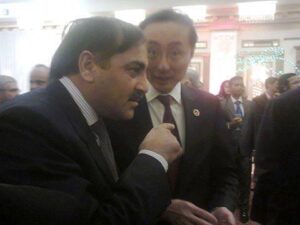By Qamar Bashir
In a surprising and dramatic policy reversal, President Donald Trump has announced a
90-day pause on his sweeping new tariffs for nearly every trading partner—except China.
The move, announced just hours after the tariffs went into effect, sent markets soaring,
calmed international anxiety, and opened a temporary window for diplomatic
negotiations. But behind the scenes, this abrupt about-face reveals a complex interplay of
economic realities, political pressures, and global trade dynamics that forced the
president to back down from a central tenet of his economic ideology.
The president’s post on Truth Social—“a 90 DAY PAUSE”—marked a decisive pivot.
While car, steel, and aluminum tariffs remain intact, the suspension of broader trade taxes
sent the S&P 500 soaring over 9% in a single day, its best performance since the 2008
financial recovery. Tech stocks, airlines, and auto manufacturers all rallied sharply. Even
companies still burdened by tariffs, like Ford and GM, saw significant gains.
In justifying his reversal, Trump said he acted on “instinct” and felt that markets and
citizens alike were getting “yippy” and “a little bit afraid.” His folksy language barely
concealed the broader truth: the markets were plummeting, and with them, investor
confidence in the administration’s economic management.
The president’s change of course was likely motivated by a convergence of several
powerful factors. The bond market had shown signs of panic, signaling fears of a looming
recession. Meanwhile, the dollar wobbled against global currencies, further stoking
anxiety. Perhaps most compellingly, spontaneous demonstrations against the tariffs
erupted across the country—from New York to San Francisco—as thousands of
Americans protested what they saw as an unjustified and reckless trade war that risked
jobs, raised prices, and destabilized global partnerships.
Economists and business leaders had warned for weeks that a prolonged tariff war would
increase production costs, especially in key industries reliant on imported raw materials
and components. American companies—particularly small- and medium-sized
manufacturers—began sounding the alarm, saying they could not pivot supply chains
overnight. Even powerful corporate allies of Trump began voicing discontent.
The president’s isolation of China in this tariff pause also underscores the deep
geopolitical rivalry between the two economic superpowers. The decision to raise tariffs
on all Chinese imports to 125% followed Beijing’s retaliatory move of increasing levies
on U.S. goods to 84%. Both sides have now entered a tit-for-tat escalation, further
straining relations already tested by restrictions on technology firms, export bans, and
accusations of economic espionage.
China’s Ministry of Commerce responded harshly, placing export controls on 12
American companies and designating six more as “unreliable entities”—effectively
banning them from Chinese markets. Trump’s team insists that the tariff approach is
working, pointing to concessions from countries like Vietnam, Cambodia, and Ecuador,
which have signaled willingness to reduce trade barriers and open markets to American
products.
Still, there is a growing debate over whether tariffs are the right mechanism to restore
American industrial dominance. While the idea is to incentivize domestic production,
there are challenges. For instance, the U.S. auto industry has struggled with quality and
innovation, leading many consumers to prefer foreign-made vehicles known for their
durability, fuel efficiency, and after-sales service. If the administration hopes to make
tariffs a long-term policy tool, American industries will need to dramatically improve
their competitiveness, not just rely on protectionism.
Trade barriers alone cannot revive domestic manufacturing unless paired with major
investments in innovation, training, and infrastructure. History shows that protectionism,
while politically appealing, can often stifle innovation by reducing competition. In
today’s fast-paced global economy, the U.S. must invest in research and development,
automation, and green technologies if it wants to lead again.
The economic impact of tariffs also affects the dollar’s value. When the U.S. imposes
tariffs on imports, it increases the cost of foreign goods, often pushing the dollar higher
as demand rises. Conversely, retaliatory tariffs on American exports can weaken the
dollar, as foreign buyers shift away from U.S. goods. Striking the right balance is tricky,
and Trump’s pause might be seen as an effort to stabilize currency markets amid growing
global uncertainty.
Beyond economics, international reaction has played a significant role in shaping the
administration’s response. Canada, a historically close ally, reacted with rare public fury.
As one of the U.S.’s largest trading partners, Canada’s retaliatory measures and national
outrage rattled policymakers. The idea that America’s most dependable neighbors were
being punished indiscriminately undermined Trump’s case for fair trade and weakened
U.S. leadership on the world stage.
The pause also raises deeper concerns about governance. During a congressional hearing
on Wednesday, the president’s trade representative, Jamieson Greer, was caught off
guard by the announcement. Lawmakers expressed frustration, with Rep. Steven
Horsford of Nevada shouting, “This is amateur hour.” The last-minute decision, made
without consulting key officials or allies, raises questions about how trade policy is being
formulated and whether it reflects a coherent long-term strategy or moment-to-moment
reactions.
Meanwhile, Trump’s broader policy direction continues to raise alarms. On the same day
as the tariff pause, he reaffirmed plans to revive fossil fuel extraction and reopen coal
mines, reversing years of environmental progress. Critics warn that such policies could
trigger a global race toward dirty energy production, exacerbating climate change and
harming public health.
In light of these developments, it would be prudent for the administration to extend the
spirit of the 90-day tariff pause to its energy agenda as well. Just as tariffs deserve
reevaluation, so too does America’s environmental policy. Rethinking coal and fossil fuel
revival with the same urgency and pragmatism could prevent long-term damage to the
planet and bolster America’s standing as a responsible global leader.
In the end, Trump’s 90-day pause on tariffs is both a concession and an opportunity. It
reflects the limits of unilateralism in a globally connected world and offers a chance to
recalibrate. The U.S. can use this moment not only to renegotiate fairer trade deals but
also to reinvest in its own industrial base, green technology, and diplomatic alliances.
Whether this pause leads to a sustainable strategy—or merely delays another
storm—remains to be seen.




